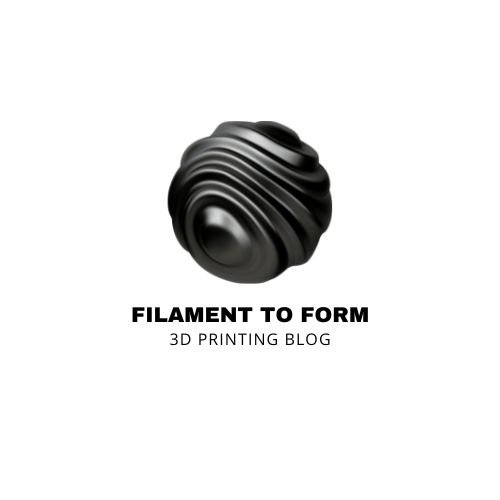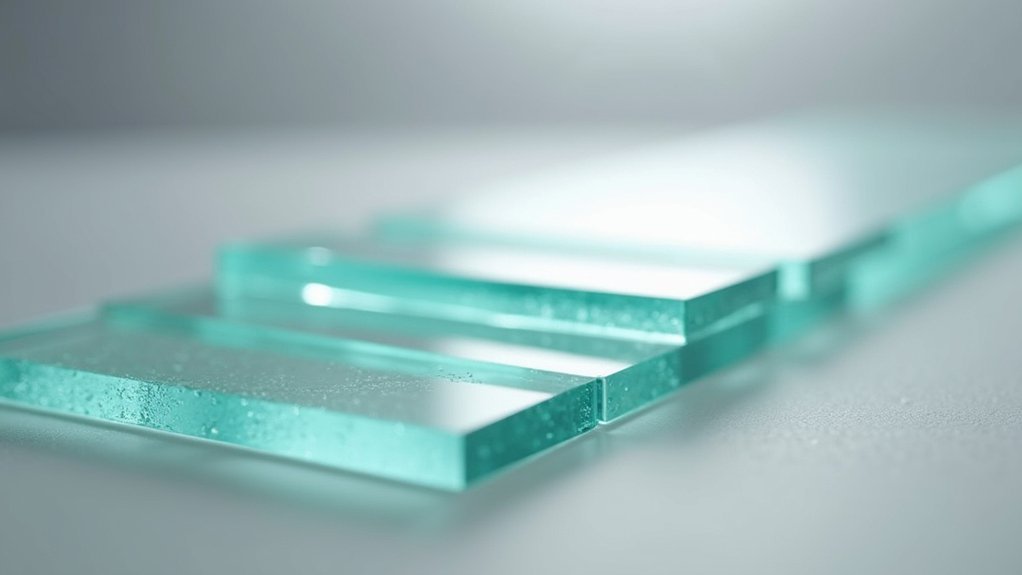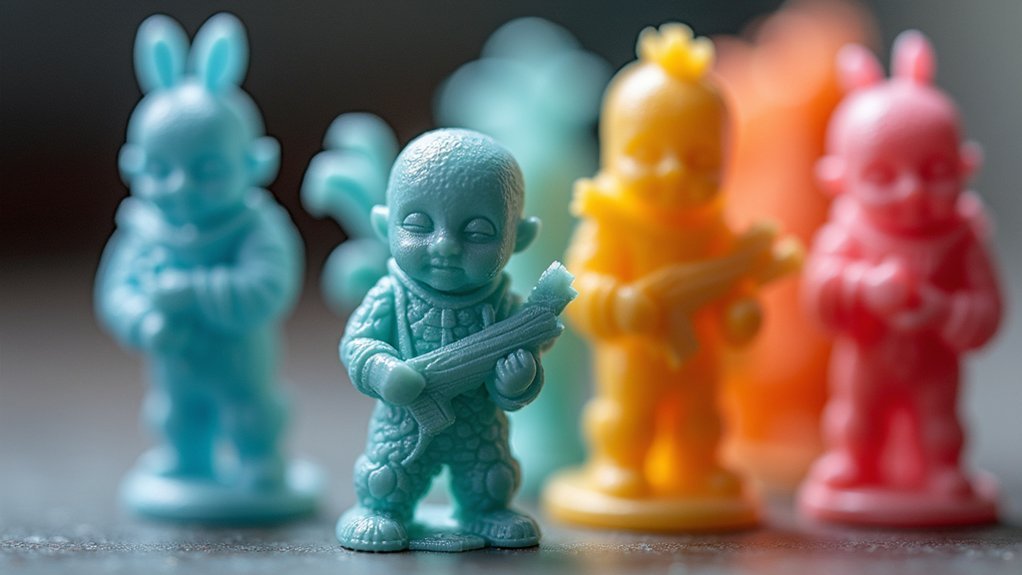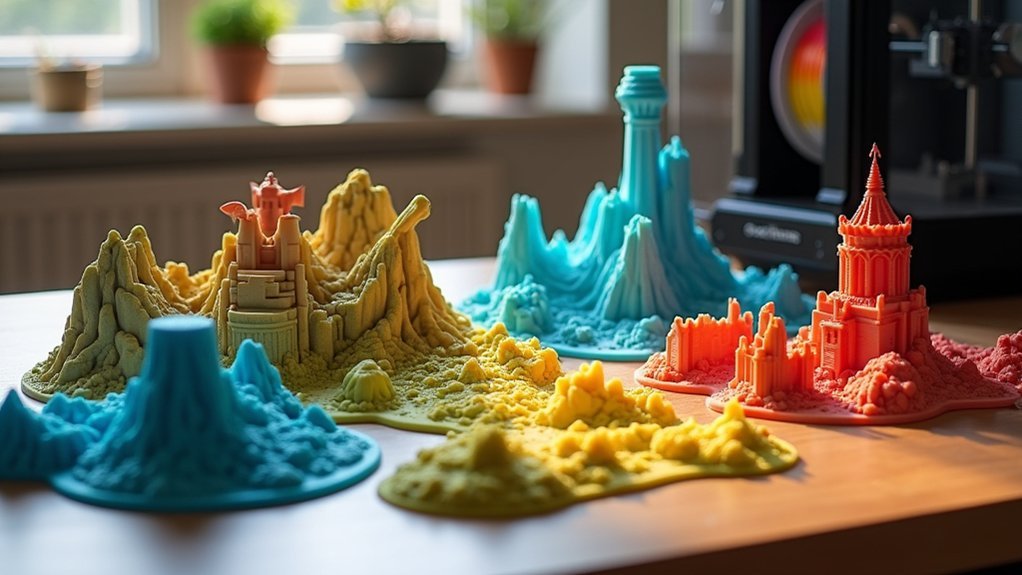You’ve probably noticed those frustrating layer lines and imperfections that keep your 3D prints from looking truly professional. The secret to achieving that coveted mirror-smooth finish isn’t just in your printer settings or filament choice—it starts with your build surface. Glass print beds can transform your printing game, but not all glass surfaces are created equal. Choosing the wrong one could actually make your surface quality worse than where you started.
Creality Ender 3 Glass Bed Upgraded (235×235×4mm)
If you’re seeking a reliable upgrade for your Creality Ender 3 that delivers consistent results, the Creality Ender 3 Glass Bed Upgraded stands out with its chemically tempered glass construction and composite nano molecule coating. This 235×235×4mm bed offers exceptional flatness recovery at 0.15mm, ensuring uniform surfaces for every print. The microporous composite material enables easy model removal within one minute, while the protective film prevents scratches and dust accumulation. You’ll experience strong adhesion when heated, reducing print failures considerably. Though larger prints may require additional removal techniques, users consistently praise its durability and performance, making it an excellent long-term investment.
Best For: 3D printing enthusiasts with Creality Ender 3 printers who want improved print quality, consistent adhesion, and easy model removal without frequent bed replacements.
Pros:
- Exceptional flatness recovery at 0.15mm with chemically tempered glass construction ensures consistent, high-quality prints
- Microporous composite material allows for easy model removal within one minute while maintaining strong heated adhesion
- Durable design with protective anti-scratch coating and 2-year warranty provides excellent long-term value
Cons:
- Larger prints may require additional removal techniques and can be more difficult to remove compared to flexible surfaces
- Strong adhesion may necessitate bed re-leveling after significant prints
- Glass surface may show wear after 1-2 years of heavy use, requiring eventual replacement
Borosilicate Glass 3D Printer Bed 235x235x3.8mm for Ender Series
Ender series owners seeking a reliable upgrade from magnetic or stock print surfaces will find the Borosilicate Glass 3D Printer Bed 235x235x3.8mm delivers exceptional thermal stability and consistent printing results. You’ll appreciate its 520°C maximum operating temperature and ultra-low thermal expansion properties that resist warping under heat. The 3.8mm thickness provides durability without requiring additional clips for securing.
You can print various filaments including PLA, ABS, and PETG on its smooth surface. Apply thin glue layers before printing and clean regularly with water and glass cleaner. For stubborn prints, you’ll find freezing the glass plate facilitates easier removal. Remember to adjust your Z-axis settings during installation for ideal performance.
Best For: Ender 3D printer owners looking to upgrade from magnetic or stock print surfaces who want improved print quality, thermal stability, and compatibility with multiple filament types.
Pros:
- Exceptional thermal stability with 520°C maximum operating temperature and ultra-low thermal expansion that resists warping
- Universal compatibility with various filament types (PLA, ABS, PETG) and provides smooth, flat surface for consistent print quality
- Easy maintenance and cleaning with water and glass cleaner, plus no additional clips needed due to sturdy 3.8mm thickness
Cons:
- Requires Z-axis limit switch adjustment during installation which may be challenging for beginners
- PETG filament can fuse to the glass surface, requiring careful adhesive application and removal techniques
- Regular maintenance needed with glue application before printing and cleaning after every 4-5 prints for optimal performance
Creality Ender 3 Glass Bed Upgraded Build Surface Plate, 235x235x4mm
Creality’s glass bed upgrade transforms your 3D printing experience with its exceptional flatness and superior adhesion properties. You’ll achieve 0.08mm variance with proper leveling, enabling larger prints without edge curling concerns. The 235x235x4mm plate works seamlessly with Ender-3, Ender-3 Pro, Ender-5, and CR-20 series printers. You’ll notice improved thermal consistency during printing, and prints pop off effortlessly once cooled. While it excels with PETG, you’ll need glue stick for reliable PLA adhesion. The thermal mass provides even temperature distribution, making this upgrade considerably superior to stock magnetic surfaces for consistent results.
Best For: Ender 3D printer owners seeking improved build surface flatness and better adhesion for PETG printing who don’t mind using glue stick for PLA materials.
Pros:
- Exceptional flatness with 0.08mm variance enabling larger prints without edge curling or adhesion issues
- Superior thermal consistency and even temperature distribution due to thermal mass compared to stock magnetic surfaces
- Easy print removal once cooled with prints popping off effortlessly without damage
Cons:
- Requires glue stick for reliable PLA adhesion, making it less convenient than some alternatives
- Must wait for bed to cool completely before removing prints, which can slow workflow
- Not compatible with Ender 3 V3 SE unless the magnetic layer is manually removed
Mefine Ender 3 Glass Bed for 3D Printer (235x235x4mm)
Budget-conscious makers seeking a reliable upgrade will find the Mefine Ender 3 Glass Bed delivers exceptional value without compromising performance. This 235x235x4mm borosilicate glass plate withstands temperatures up to 400℃ while providing superior flatness compared to magnetic surfaces. You’ll appreciate the microporous coating that guarantees strong adhesion during printing and effortless removal once cooled. The included clips secure it firmly to your hotbed, eliminating movement issues. With 4.5-star ratings from nearly 2,700 users, you’re getting proven reliability. Remember to adjust your Z-axis switch and clean with isopropyl alcohol for ideal results.
Best For: Budget-conscious 3D printer enthusiasts who want to upgrade from stock beds to achieve better print adhesion, flatness, and overall print quality on compatible Ender 3 series and similar Cartesian printers.
Pros:
- Superior flatness and temperature resistance up to 400℃ with genuine borosilicate glass construction
- Microporous coating provides excellent adhesion during printing and easy release when cooled without requiring tools
- Strong customer satisfaction with 4.5-star rating from nearly 2,700 reviews and responsive customer support
Cons:
- Requires Z-axis limit switch adjustment due to increased bed thickness which adds setup complexity
- Included clips may interfere with print heads if not positioned carefully during installation
- Surface can be damaged by improper cleaning agents like nail polish remover or tape residue
Creality Ender 3 Glass Bed Upgraded 3D Printer Platform (235x235x4mm)
With its microporous carborundum coating and 8 Mohs hardness rating, the Creality Ender 3 Glass Bed delivers exceptional adhesion without requiring tapes or release agents. You’ll appreciate how this tempered glass plate works seamlessly with ABS, PLA, and PETG filaments while withstanding temperatures up to 400°C. The 235x235x4mm dimensions make it compatible with Ender 3 Pro/V2/S1/S1 Pro/V2 Neo, Ender 5 Pro, and CR 20 models. You can easily remove prints after cooling, though larger prints on the textured side require more effort. Regular cleaning with glass cleaner maintains its spotless surface for consistent performance.
Best For: Ender 3 series users seeking improved print adhesion and quality without the hassle of tapes or adhesives, especially those printing with ABS, PLA, and PETG filaments.
Pros:
- Excellent adhesion with microporous coating that eliminates need for tapes or release agents
- Durable construction with 8 Mohs hardness rating and heat resistance up to 400°C
- Improved print quality and bed leveling compared to original build surfaces
Cons:
- Difficulty removing larger prints, particularly on the textured side
- Installation may require tricky bed leveling adjustments with reports of uneven center areas
- Minimal wear marks on textured surface may transfer to subsequent prints
Factors to Consider When Choosing Glass Print Beds for Mirror-Smooth Finishes
When you’re selecting a glass print bed for mirror-smooth finishes, you’ll need to evaluate several critical specifications that directly impact your print quality. The thickness and flatness of the glass determine how well it maintains a level surface, while the surface coating type affects how easily your prints adhere and release. You’ll also want to confirm the bed’s temperature resistance capabilities, adhesion properties, and compatibility with your specific 3D printer model.
Glass Thickness and Flatness
Although many 3D printing enthusiasts focus primarily on nozzle temperature and filament quality, the physical characteristics of your glass print bed play an equally essential role in achieving those coveted mirror-smooth finishes. You’ll want glass thickness between 3.8mm to 4mm, as thicker glass provides superior durability and resistance to warping under heat. More importantly, guarantee your glass maintains a flatness variance of 0.08mm or less for smooth finishes and even contact between prints and bed surface.
Choose chemically tempered or borosilicate glass for enhanced strength and stability at elevated temperatures. These materials retain their flatness over time better than standard glass. Regular cleaning and maintenance of your glass surface will preserve its flatness and prevent imperfections that compromise print quality.
Surface Coating Types
Beyond the physical properties of your glass bed, the surface coating you select determines how well your prints adhere during the printing process and release afterward. Microporous coatings enhance grip during printing, preventing warping and edge curling that can ruin your prints. You’ll find that different coatings affect print removal differently – some surfaces allow prints to pop off easily once cooled, while others may require additional techniques for larger models. Borosilicate glass coatings offer ultra-low thermal expansion and heat resistance, contributing to stable printing conditions and improved surface quality. To optimize performance, you’ll need regular maintenance including cleaning and applying thin adhesive layers for consistent mirror-smooth finishes.
Temperature Resistance Capabilities
Since high-temperature printing requires materials that won’t crack or warp under extreme heat, you’ll need to prioritize glass beds with exceptional temperature resistance capabilities. Borosilicate glass print beds offer ultra-low thermal expansion and withstand temperatures up to 520 degrees Celsius, making them ideal for high-temperature applications. Chemically tempered glass provides superior hardness and endures thermal shock during frequent heating and cooling cycles without compromising structural integrity.
You should consider plate thickness when evaluating temperature resistance, as thicker glass plates resist warping better under heat stress. This resistance is vital for maintaining mirror-smooth finishes. Additionally, microporous composite coatings enhance adhesion when heated, improving performance at elevated temperatures. Regular cleaning and maintenance guarantee peak performance, as residues can compromise both temperature resistance and print quality.
Print Adhesion Properties
Adhesion determines whether your prints stick properly to the glass surface or fail mid-process, making it the most vital factor for achieving mirror-smooth finishes. You’ll want glass beds with high viscosity and strong adhesive properties that enhance print quality while minimizing warping. Consider microporous composite coatings that greatly improve adhesion, allowing your models to stick firmly without additional adhesives.
Temperature control becomes essential here—heated glass surfaces provide superior adhesion, especially for materials like ABS and PETG. You’ll also need proper bed leveling to guarantee uniform contact across the entire print area. Don’t overlook maintenance either; regularly cleaning your glass surface with appropriate cleaners sustains adhesion properties and prolongs lifespan, guaranteeing consistent mirror-smooth results.
Compatibility With Printers
When selecting a glass print bed, you’ll need to verify the dimensions precisely match your printer’s build area—most popular models like the Ender series require 235x235mm beds, but deviations even by a few millimeters can cause installation headaches.
Check your specific printer model’s compatibility requirements, as some glass beds work across multiple machines while others are restricted to certain models. Pay attention to thickness specifications—common options include 3.8mm and 4mm—since variations affect installation and performance.
Confirm the glass bed’s maximum operating temperature matches your printer’s heating capabilities. High-temperature materials like ABS and PETG demand beds that withstand sustained heat without warping or cracking.
Research user feedback about installation and bed leveling requirements for your printer model, as some glass beds need more precise adjustments.
Frequently Asked Questions
How Do I Properly Clean Glass Print Beds Without Damaging Them?
Use isopropyl alcohol and a microfiber cloth to gently wipe your glass bed. Don’t use abrasive materials or harsh chemicals. Let it cool completely before cleaning, and avoid applying excessive pressure that could crack the surface.
What Bed Temperature Works Best With Glass Surfaces for Different Filament Types?
You’ll want 60°C for PLA, 70-80°C for PETG, and 90-110°C for ABS on glass beds. Start lower and increase if you’re experiencing warping or poor adhesion with your specific filament brand.
Can Glass Beds Be Used With Flexible Filaments Like TPU?
You can use glass beds with TPU, but adhesion’s challenging. You’ll need proper bed temperature settings, slower print speeds, and possibly adhesion aids like hairspray or glue stick for successful flexible filament printing.
How Do I Fix Glass Bed Adhesion Problems During Printing?
You’ll need to clean your glass bed thoroughly with isopropyl alcohol, adjust your nozzle height closer to the bed, and consider using adhesion aids like hairspray or glue stick for better filament bonding.
Are Glass Beds Compatible With Auto Bed Leveling Sensors?
You’ll find most glass beds work perfectly with auto bed leveling sensors. Inductive sensors detect the metal beneath glass, while capacitive and BLTouch sensors directly sense the glass surface for accurate measurements.





Leave a Reply